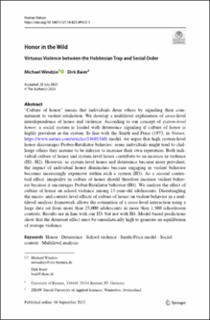Please use this identifier to cite or link to this item:
https://doi.org/10.21256/zhaw-28627| Publication type: | Article in scientific journal |
| Type of review: | Peer review (publication) |
| Title: | Honor in the wild : virtuous violence between the Hobbesian trap and social order |
| Authors: | Windzio, Michael Baier, Dirk |
| et. al: | No |
| DOI: | 10.1007/s12110-023-09455-1 10.21256/zhaw-28627 |
| Published in: | Human Nature |
| Volume(Issue): | 34 |
| Issue: | 3 |
| Page(s): | 400 |
| Pages to: | 421 |
| Issue Date: | 6-Sep-2023 |
| Publisher / Ed. Institution: | Springer |
| ISSN: | 1045-6767 1936-4776 |
| Language: | English |
| Subjects: | Honor; Deterrence; School violence; Smith-Price model; Social context; Multilevel analysis |
| Subject (DDC): | 301: Sociology and anthropology |
| Abstract: | “Culture of honor” means that individuals deter others by signaling their commitment to violent retaliation. We develop a multilevel explanation of cross-level interdependence of honor and violence. According to our concept of system-level honor, a social system is loaded with deterrence signaling if culture of honor is highly prevalent in the system. In line with the Smith and Price (1973, in Nature, https://www.nature.com/articles/246015a0) model, we argue that high system-level honor discourages Prober-Retaliator behavior: some individuals might tend to challenge others they assume to be inferior to increase their own reputation. Both individual culture of honor and system-level honor contribute to an increase in violence (H1; H2). However, as system-level honor and deterrence become more prevalent, the impact of individual honor diminishes because engaging in violent behavior becomes increasingly expensive within such a system (H3). As a second contextual effect, inequality in culture of honor should therefore increase violent behavior because it encourages Prober-Retaliator behavior (H4). We analyze the effect of culture of honor on school violence among 15-year-old adolescents. Disentangling the micro- and context-level effects of culture of honor on violent behavior in a multilevel analysis framework allows the estimation of a cross-level interaction using a large data set from more than 25,000 adolescents in more than 1,300 schoolroom contexts. Results are in line with our H3, but not with H4. Model-based predictions show that the deterrent effect must be unrealistically high to generate an equilibrium of average violence. |
| Further description: | Erworben im Rahmen der Schweizer Nationallizenzen (http://www.nationallizenzen.ch) |
| URI: | https://digitalcollection.zhaw.ch/handle/11475/28627 |
| Fulltext version: | Published version |
| License (according to publishing contract): | CC BY 4.0: Attribution 4.0 International |
| Departement: | Social Work |
| Organisational Unit: | Institute of Delinquency and Crime Prevention (IDK) |
| Appears in collections: | Publikationen Soziale Arbeit |
Files in This Item:
| File | Description | Size | Format | |
|---|---|---|---|---|
| 2023_Windzio-Baier_Honor-in-the-wild.pdf | 1.34 MB | Adobe PDF |  View/Open |
Show full item record
Windzio, M., & Baier, D. (2023). Honor in the wild : virtuous violence between the Hobbesian trap and social order. Human Nature, 34(3), 400–421. https://doi.org/10.1007/s12110-023-09455-1
Windzio, M. and Baier, D. (2023) ‘Honor in the wild : virtuous violence between the Hobbesian trap and social order’, Human Nature, 34(3), pp. 400–421. Available at: https://doi.org/10.1007/s12110-023-09455-1.
M. Windzio and D. Baier, “Honor in the wild : virtuous violence between the Hobbesian trap and social order,” Human Nature, vol. 34, no. 3, pp. 400–421, Sep. 2023, doi: 10.1007/s12110-023-09455-1.
WINDZIO, Michael und Dirk BAIER, 2023. Honor in the wild : virtuous violence between the Hobbesian trap and social order. Human Nature. 6 September 2023. Bd. 34, Nr. 3, S. 400–421. DOI 10.1007/s12110-023-09455-1
Windzio, Michael, and Dirk Baier. 2023. “Honor in the Wild : Virtuous Violence between the Hobbesian Trap and Social Order.” Human Nature 34 (3): 400–421. https://doi.org/10.1007/s12110-023-09455-1.
Windzio, Michael, and Dirk Baier. “Honor in the Wild : Virtuous Violence between the Hobbesian Trap and Social Order.” Human Nature, vol. 34, no. 3, Sept. 2023, pp. 400–21, https://doi.org/10.1007/s12110-023-09455-1.
Items in DSpace are protected by copyright, with all rights reserved, unless otherwise indicated.